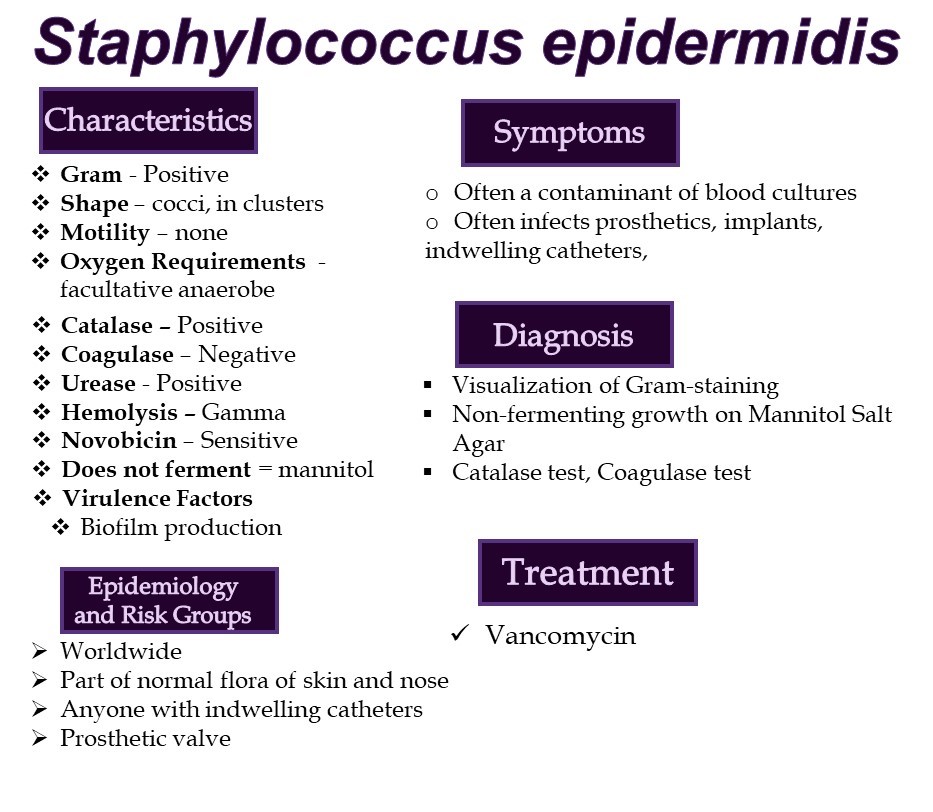Staphylococcus epidermidis is unsurprisingly a common skin flora. (epidermis…get it?) It uniquely loves to create biofilms which makes it particularly awesome at sticking to plastic. This means that anytime you shove plastic into a body through the skin (indwelling catheters, IV catheters, prosthetic valves, CSF shunts, implants, etc), you have the potential for infection with this guy. That biofilm also makes it very difficult to treat with antibiotics, because it’s hard to penetrate that sticky goop. Therefore, treat this nasty bugger with vancomycin.

Staphylococcus saprophyticus is the second most common cause of UTIs (after E. coli), and especially haunts young, sexually active women because…skin. This organism is urease-positive which helps it survive the acidic environments of the urinary tract. It also contains many aquaporins that help it regulate the pH around all that urine.


A 19-year-old female presents to the clinic with painful urination for the past 2 days. Vital signs are all normal. She reports that she recently became sexually active, and uses barrier protection methods. Urinalysis reveals the presence of Gram-positive organisms, and the absence of WBCs, casts, or RBCs. Which of the following best describes the most likely causative agent?
A. Catalase-positive, coagulase-positive, beta-hemolytic
B. Catalase-positive, coagulase-negative, novobicin-resistant
C. Catalase-positive, coagulase-negative, novobicin-sensitive
D. Catalase-negative, coagulase-negative, optochin-sensitive
E. Catalase-negative, coagulase-negative, optochin-resistant
F. Catalase-positive, fimbrae-positive, flagella-positive
This patient has symptoms of uncomplicated cystitis.
- uncomplicated cystitis is a simple case of UTI, complicated UTIs occur when the patient is male or has a catheter or other complication.
- The presence of casts, WBCs or RBCs would suggest a case of pyelonephritis
A. This describes Staphylococus aureus which is rarely a cause of UTIs since it doesn’t have urease
C. This describes Staphylococcus epidermidis, which can be a cause of UTIs because it has urease, but is not commonly one.
D. This describes Streptococcus pneumoniae, which is not a cause of UTI
E. This describes the Streptococcus viridans group which is not often a cause of UTI
F. This describes E. coli, particularly the UPEC serotype, which is the most common cause of UTIs, but are Gram-negative organisms, and therefore ruled out for this patient.
Therefore,

A 32-year-old male presents in the intensive care unit after blunt trauma requiring the placement of a central line in the left internal jugular, which was placed prior to arrival in the critical care unit. On day 10 of admission, the patient developed worsening hypotension, a temperature of 104.1, and 110 heart rate. Physical examination reveals erythema around the central line, and find that the line has not been changed since ICU admission. Blood cultures were taken and the organism was found to be sensitive to novobicin, and catalase-positive. Which of the following characteristics best describes the most likely organism?
A. Ferments mannitol
B. Coagulase positive
C. Urease positive
D. Grows in chains
First, diagnose the patient.
This patient is hypotonic, tachycardic, and has a fever. This indicates some sort of shock. Growth in the blood cultures clarifies this diagnosis as septic shock (caused by infectious agents). The most likely organism caused by an infected central line is Staphylococcus aureus, however, the fact that it’s sensitive to novobicin indicates that it’s Staphylococcus epidermidis. Remember, because of its biofilm, this organism is really hard to kill via antibiotics.
A. Describes Staphylococcus aureus. Mannitol Salt Agar plates can be used to differentiate between S. aureus and S. epidermidis/saprophyticus. S. epidermidis doesn’t ferment mannitol
B. Staphylococcus aureus is coagulase positive. S. epidermidis/saprophyticus are not
D. Streptococcus spp. organisms often grow in chains. No Staphylococcus spp. grow in chains.
Therefore,

__________________________________________________________________________________________
Want to discuss the treatment options? Would you like to add a factoid to the information? Please, post a comment, they are all anonymous!


